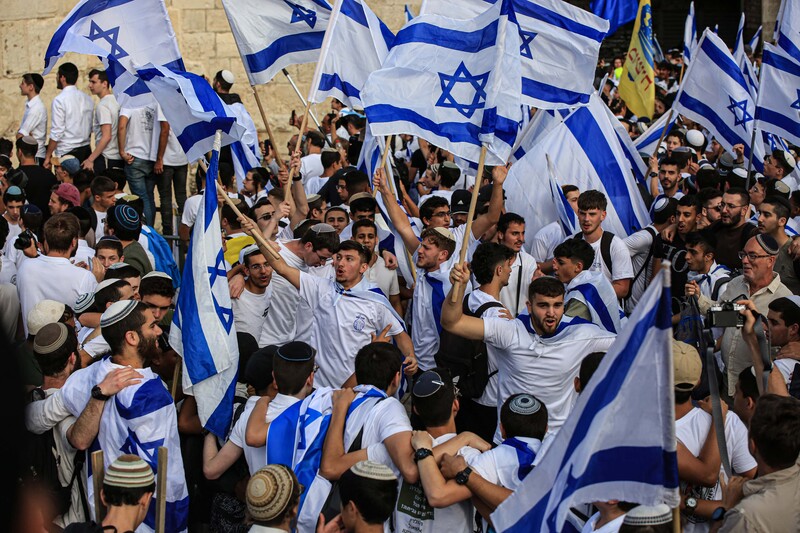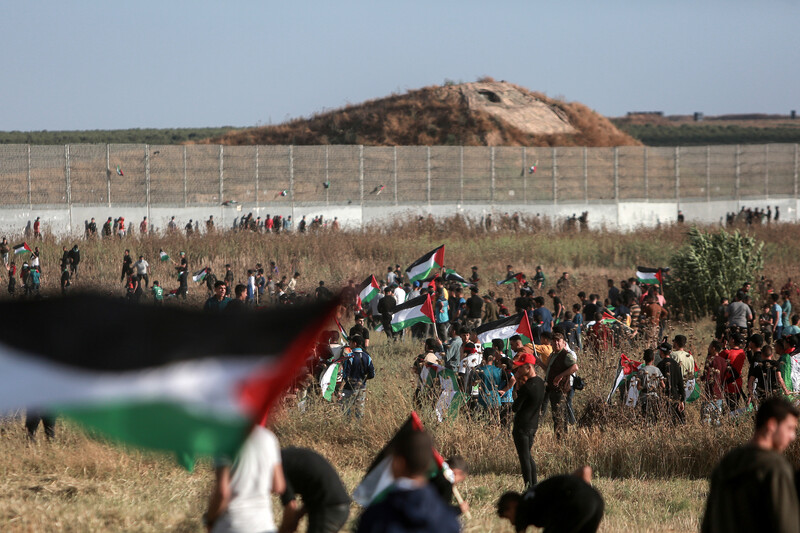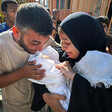Rights and Accountability 19 May 2023

Religious ultranationalists rally outside of the Damascus Gate to Jerusalem’s Old City on 18 May.
SOPA ImagesIsrael’s annual “Death to the Arabs” religious nationalist spectacle in Jerusalem’s Old City on Thursday featured harassment and assaults against Palestinians and journalists by both participants and police.
Marchers chanted genocidal slogans such as “we will burn your village” and “I will avenge one of my two eyes from Palestine, may their name be erased.”
Officially billed as a Jerusalem Day flag rally, the event purports to celebrate Israel’s acquisition of the eastern sector of Jerusalem by force following the 1967 War and its subsequent occupation and illegal annexation.Palestinians are forced to shut down their shops and their movement is restricted to make way for marchers who in recent years have come to be known for their racist anti-Palestinian chants as they seek to assert Jewish dominance over the entirety of the city.
This year the march came days after a ceasefire that ended a five-day Israeli surprise attack on Gaza that left 33 Palestinians dead in the coastal enclave.During the escalation, an Israeli woman and Palestinian laborer from Gaza were killed by rockets fired from the territory in response to a series of assassinations of prominent figures belonging to the Islamic Jihad resistance faction.
Israel went ahead with the Jerusalem event despite its cancellation being one of Islamic Jihad’s initial ceasefire conditions. Prime Minister Benjamin Netanyahu doubled down on the march and its provocative route through the Muslim Quarter of the Old City, despite pressure from the Biden administration to change the route, lest he appear to compromise with the Palestinian resistance.
The march threatened to further destabilize an already fragile situation.
The flag march was a catalyst for the May 2021 war in Gaza that left more than 250 Palestinians dead in the besieged territory and 12 people dead in Israel.
While this year the event passed without a dramatic escalation, Palestinians endured ramped-up racist violence that is a daily reality in the city.
Journalists attacked
According to the Tel Aviv daily Haaretz, “before the march reached Jerusalem’s Old City, clashes erupted between Jewish marchers and Palestinian residents.”
The paper added that “in one incident, verbal insults hurled by Jewish participants turned into pushing and physical assault against the Palestinians. One resident was knocked to the ground and briefly beaten; law enforcement intervened and dispersed the Palestinians involved.”
Marchers also attacked journalists, including a correspondent for Haaretz. Police also assaulted journalists, including a Haaretz photographer and CNN correspondent Ben Wedeman.
The BBC’s Middle East correspondent Tom Bateman described journalists being hit with projectiles at Damascus Gate:
Ahead of Israeli extremists’ incursion at al-Aqsa, Palestinian community leader Fakhri Abu Diab was assaulted by police at the holy site while giving a live telephone interview with Israel’s Ynet news: Police threw Abu Diab’s phone to the ground, breaking it, and forced him out of the al-Aqsa mosque compound and ordered him to not return to the Old City, The Guardian newspaper reported. Haaretz noted that during the rally and march, “hundreds were filmed shouting ‘death to Arabs’ and ‘a Jew is a soul, an Arab is the son of a whore’ near the Damascus Gate” – the eastern entrance to the Muslim Quarter of the Old City and a center of Palestinian cultural and social life.Several Israeli lawmakers and some cabinet ministers participated in the march this year, including extremist finance minister Bezalel Smotrich:
Ukrainian-born Yuli Edelstein, a lawmaker belonging to Netanyahu’s Likud party, was there as well: Yizhak Kroizer, a lawmaker belonging to public security minister Itamar Ben-Gvir’s Jewish Power party, said that the event is about “applying sovereignty to all parts of Jerusalem.”Ben-Gvir, who holds authority over Israel’s police, arrived at Damascus Gate with a police escort to participate in the march.
CNN reported that “some of the marchers chanted: ‘Who is here? The prime minister is here,’ suggesting that they think Ben-Gvir, not Prime Minister Benjamin Netanyahu, controls Israel’s government.”Israel Katz, the energy minister who belongs to Netanyahu’s Likud Party, used the occasion to threaten Yahya Sinwar, the leader of Hamas in Gaza, with assassination.
Earlier in the day, The Times of Israel reported, lawmakers from Likud and Jewish Power made a provocative tour of the al-Aqsa mosque complex with around 1,200 Jews. Some openly prayed in violation of the status quo arrangements at the holy site.
Insecurity
The violent spectacle reveals both the insecurity of the Zionist project in Palestine and the racist violence that is at its core.
Israel’s policy towards Palestinians in Jerusalem is in pursuit of demographic engineering to ensure a Jewish majority in the city, using all the tools at its disposal: settlement-building, forcing Palestinians from their homes, revoking Palestinian residency rights, home demolitions and so on.The al-Aqsa mosque compound, and its centrality to Palestinian identity, is a primary focus of Israeli extremists who seek absolute Jewish domination from the Jordan River to the Mediterranean Sea.
The so-called Temple movement, which has backers in Israel’s parliament and religious establishment, seeks to increase the number of Jews visiting the al-Aqsa mosque compound, one of the holiest sites for Muslims.
Temple movement activists ultimately seek the destruction of the Dome of the Rock, also housed in the mosque compound, and the construction of a Jewish temple in its place.
Israel’s antiquities authority recently released a rendering of a future Jewish temple at the site of al-Aqsa as part of a promotion of biblical tourism.
The Israeli-controlled Jerusalem municipality, in partnership with other government entities and and the settler group Elad, have advanced the demolition of Palestinian homes in Silwan, a neighborhood near Jerusalem’s Old City, to establish a theme park named after the biblical King David. Even if there wasn’t a response from the resistance in Gaza, where protests were held along the boundary with Israel on Thursday, the Jerusalem Day march and the extremist movement it represents may still provoke one.
Palestinians protest Israel’s annual Jerusalem Day flag march east of Gaza City along the boundary fence with Israel, 18 May.
APA imagesBasim Naim, Hamas’ head of political and foreign relations, told Al Jazeera before this year’s Jerusalem Day rally that increasing power in the hands of Israel’s extreme right has led to dangerous developments such as the storming of the Old City’s Muslim Quarter and attempts to march through al-Aqsa.
“Hamas is not eager to escalate. But if it is about Jerusalem, about al-Aqsa, about [the] central pillar of the Palestinian cause … we are ready to go to the end … to sacrifice all we can,” Naim added.
Naim accused the current Israeli government of “taking the whole conflict into a religious corner” that may spill over “in other countries.”
“It is not a conflict between Gaza and Israel – it is a conflict between Palestinians everywhere and Israel,” Naim said. “And if it is about the holy places, it means that you are recruiting millions and millions of Muslims to the same conflict.”
A conversion of “a political conflict into a religious one,” Naim said, would be “very difficult, if not impossible, to solve.”





